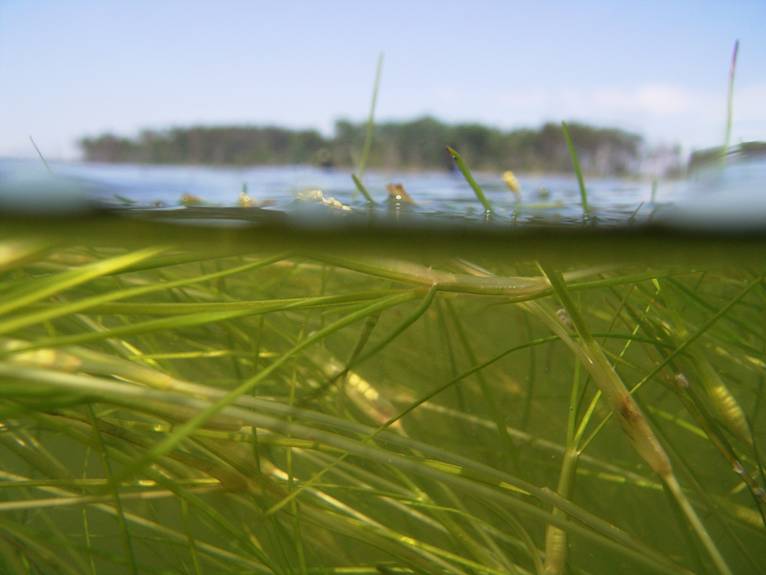Chesapeake Bay Underwater Grasses Increased in 2022
Annual aerial survey showed continuing recovery

Widgeon grass is now the most common submerged aquatic vegetation in the Chesapeake Bay. Maryland Department of Natural Resources photo
The Maryland Department of Natural Resources today reported a 6% increase in submerged aquatic vegetation, commonly known as SAV or underwater grasses, in Maryland’s portion of the Chesapeake Bay in 2022. Scientists mapped 37,297 acres of underwater grasses in Maryland during the annual survey. The results represent 47% of the state’s 2025 restoration target and 33% of the ultimate restoration goal of 114,065 acres.
The Chesapeake Bay experienced moderate to dry conditions in 2022, which may have contributed to the increase. Underwater grass acreage in the Bay decreased significantly in 2019 and 2020 after heavy rains inundated the region in 2018. The resulting runoff brought more nutrient and sediment pollution to the Chesapeake Bay, which clouds the water and blocks sunlight from reaching underwater grass beds.
“While we celebrate continued positive signs for recovery in the Chesapeake Bay, we must remain vigilant to build resiliency for this vital marine resource,” said Maryland Department of Natural Resources Secretary Josh Kurtz. “To do so, we are evaluating ways to restore habitats to promote underwater grass growth. The Moore-Miller Administration is focused on ensuring these types of clean water benefits are distributed across Maryland’s watershed to provide recreational and economic opportunities for all who rely on the Bay.”
Underwater grasses play a crucial role in the health of the Chesapeake Bay ecosystem by providing habitat and food for numerous species of fish, crabs, and waterfowl. They improve water quality by absorbing excess nutrients, reducing sediment erosion, and enhancing oxygen levels. Underwater grasses also reduce acidification associated with climate change, which benefits shellfish like crabs, oysters, clams, and scallops.
Since the late 1990s, the Maryland Department of Natural Resources has been working with federal, state, and local partners to increase the acreage and diversity of underwater grasses in Maryland’s part of the Chesapeake Bay through direct restoration–planting plants or seeds of native SAV species in areas where they are not currently found.
In 2022, underwater grasses in all or part of five Maryland rivers surpassed their restoration goals. These included the Northeast River at 111%; the Bush River at 112%; the upper Gunpowder River at 149%; the Wicomico River at 124%; and the tidal fresh portion of the Chester River at 507% (the percentage of the goal attained is so high due to a very small segment restoration goal). An additional two areas in Maryland reached 75% or more of their restoration goals, including the northern Chesapeake Bay and Mattawoman Creek.
Among the notable areas showing positive growth in underwater grasses were the iconic beds in Tangier Sound and the Susquehanna Flats, along with those found in the lower Patuxent River, the Bohemia River, the Little Choptank River and the lower Pocomoke River. In a new development, scientists observed underwater grasses in Cuckold Creek on the lower Patuxent for the first time since the survey began in 1984.
More than 15 species of underwater grasses are common throughout the Chesapeake Bay and are distributed primarily based on their salinity tolerance. More than a dozen species are found in the less salty and freshwater regions of the upper Bay and tributaries. In the moderately salty waters of the mid-Bay, only about four species of grasses are commonly observed; and in the saltiest regions of the lower Bay, only widgeon grass and eelgrass are found. Eelgrass has been recovering in the lower Bay and is an important habitat to protect juvenile blue crabs; while widgeon grass recently replaced eelgrass as the most abundant underwater grass species in the Bay.
The favorable conditions in 2022 played a crucial role in the observed increases in the abundance of widgeon grass in areas with lower to medium salinity, known as mesohaline areas. However, the tidal fresh portions of the Bay and areas with lower salinities displayed minor declines in freshwater SAV species.
Significant declines in underwater grasses were observed on the upper Western Shore, particularly in the Gunpowder and Middle rivers and adjacent upper Chesapeake Bay shorelines.
The 2022 distribution of underwater grasses in the Bay and its tributaries was mapped during the annual aerial survey conducted by the Virginia Institute of Marine Science, using multispectral digital imagery and satellite imagery. The aerial imagery was acquired between May and October 2022 encompassing 180 flight lines. To supplement gaps in the aerial imagery and to provide a complete dataset for the Chesapeake Bay, additional imagery was acquired from Maxar, Planet Labs, and Spot Image. Bay-wide results are reported by the Chesapeake Bay Program.
More information on Maryland’s underwater grasses is available on the Department of Natural Resources website.

 1-888-373-7888
1-888-373-7888 233733
233733